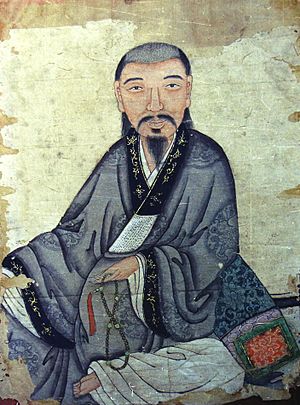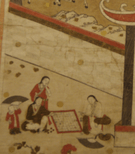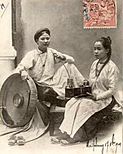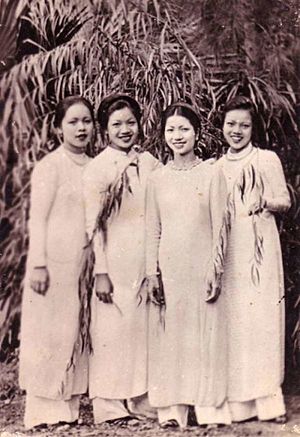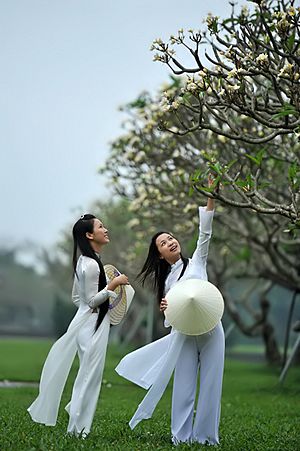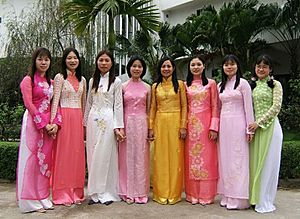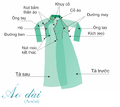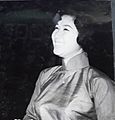Áo dài facts for kids
Quick facts for kids Áo dài |
|
|---|---|
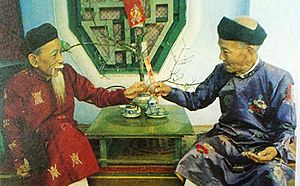 |
|
| Vietnamese name | |
| Vietnamese | áo dài |
| Hán-Nôm | 襖𨱾 |
The ao dai is the national costume of Vietnam for women. Vietnamese people wear the ao dai for special events, at school, or for work. The male version of the ao dai is called an ao gam. You can find the ao dai in every part of Vietnam. It is also worn by Vietnamese communities living in other countries.
The word áo means "clothing." The word Dài means "long." So, ao dai means "long dress." Long ago, some leaders did not like the dress. But it became popular again in the 1990s.
A modern ao dai has two main parts. It has a long dress with a high collar. It also has pants that go down to the ankles. Some ao dai dresses for parties have colorful designs. These designs might show flowers, birds, or other pictures.
The price of an ao dai can change. It depends on the fabric used and the person who makes the dress. Some fabrics are light and see-through. Because of this, people often wear light clothes underneath.
Contents
History of the Ao Dai
Early Vietnamese Clothing
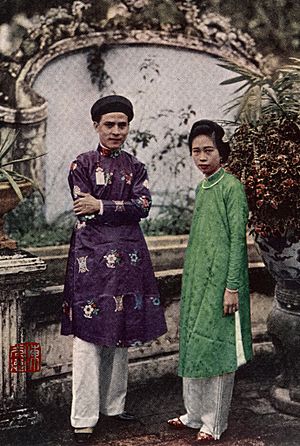
For many years, women in the countryside wore a halter top called a yếm. They wore it under a blouse or coat, with a skirt. Richer people wore a cross-collared robe. This robe was called áo giao lĩnh. It looked a bit like the Korean Hanbok or the Japanese kimono.
In 1744, a leader named Lord Nguyễn Phúc Khoát made a rule. He said that both men and women at his court must wear trousers and a gown. This gown had buttons down the front. A writer named Lê Quý Đôn called this new outfit an áo dài (long garment). This helped people from the southern court look different. The northern court wore áo giao lĩnh with long skirts.
Chinese clothing styles also influenced Vietnamese dress. The Nguyễn dynasty encouraged people to wear tunics and trousers. These were similar to clothes worn in China during the Ming and Qing dynasties. The modern Ao Dai was created in the 1920s. It added close-fitting parts to this Chinese-style tunic and trousers.
The áo ngũ thân was an older version of the ao dai. It had five panels of fabric. Two panels were sewn together in the back. Two were sewn in the front. There was also a small hidden panel under the main front one. This gown looked like it had two main parts with slits on the sides. These features are still seen in the ao dai today. The áo ngũ thân was looser and shorter than the modern ao dai. It had a high collar and buttons like the ao dai now. Women could leave the top buttons open to show their yếm underneath.
- Vietnamese clothing through the years:
-
Tran dynasty robes from a 14th-century scroll
The Ao Dai in the 20th Century
New Styles
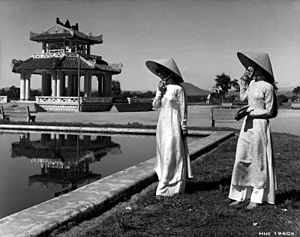
In 1917, Đồng Khánh Girl's High School in Huế opened. Its students wore the ao dai as their uniform. This uniform was very popular. The first modern ao dai was shown at a fashion show in Paris in 1921.
In 1930, an artist from Hanoi named Cát Tường (also known as Le Mur) designed a new ao dai. He was inspired by the áo ngũ thân and Paris fashion. His design reached the floor and fit the body's shape. It used special seams to make it fit well. When fabric became cheaper, there was no need for many layers. Modern ways of making fabric allowed for wider pieces. This meant less sewing.
The áo dài Le Mur became very popular. A model named Nguyễn Thị Hậu wore it in a newspaper in 1935. Artists promoted this style as a national costume for modern times. Another painter, Lê Phô, also created popular ao dai styles starting in 1934. These Western-style ao dai dresses were not worn much during World War II (1939–1945).
In the 1950s, designers in Saigon made the ao dai even tighter. This created the style we often see today. Designers Trần Kim and Dũng created a dress with special sleeves. These sleeves had a seam running from the collar to the underarm. Madame Nhu, the first lady of South Vietnam, made a collarless version popular in 1958. The ao dai was most popular from 1960 to 1975. A bright, colorful áo dài hippy appeared in 1968. The áo dài mini was a shorter version. It had slits that went above the waist and panels that reached only to the knee. This version was made for easier movement.
The Ao Dai Returns
The ao dai was always more common in the South of Vietnam. After the 1970s, the ao dai was not worn as much. This was due to economic problems and war. It was mostly worn for weddings and other special events. However, Vietnamese people living outside Vietnam kept the tradition alive. They held "Miss Ao Dai" pageants. A famous one is held every year in Long Beach, California.
The ao dai became popular again in the late 1980s. Schools and government companies started using it as a uniform. In 1989, 16,000 people attended a Miss Ao Dai Beauty Contest in Ho Chi Minh City. In 1995, a Vietnamese contestant won an award for her ao dai at a beauty pageant in Tokyo. This made people feel proud. A "craze" for the ao dai followed. It led to the dress being used more widely as a school uniform.
The Ao Dai Today
Today, the Vietnamese government supports ao dai fashion. It is often called áo dài Việt Nam to show national pride. Designer Le Si Hoang is a famous person in Vietnam. His shop in Saigon is a popular place for those who love the dress. In Hanoi, tourists can get an ao dai made on Luong Van Can Street. The city of Huế is known for its ao dai, nón lá (leaf hats), and well-dressed women.
The ao dai is now a common outfit for weddings and the Tết holiday. It is also worn for other formal events. It is a required uniform for female teachers and high school students in the South of Vietnam. Teachers can wear any color or pattern. Students usually wear plain white ao dai with small patterns like flowers. Many companies also require their female staff to wear the ao dai. So, you might see flight attendants, receptionists, bank staff, restaurant staff, and hotel workers wearing it.
The most popular ao dai style fits tightly around the upper body. It shows off the wearer's shape. Even though the dress covers the whole body, some people find it striking. This is especially true when it is made of thin fabric. A common saying is: "The ao dai covers everything, but hides nothing." The dress must be made to fit each person. It usually takes a tailor several weeks to make one. An ao dai costs about $200 in the United States and about $40 in Vietnam.
The ao dai reminds many Vietnamese people of their homeland. It brings feelings of history and tradition. Some writers say that wearing the ao dai as a school uniform has a benefit. They say it teaches students good manners, modesty, and careful behavior.
The ao dai has appeared in many movies about Vietnam. In Good Morning, Vietnam (1987), Robin Williams's character is amazed by women in ao dai when he arrives in Saigon. The films Indochine (1992) and The Lover (1992) inspired fashion brands to create ao dai collections. These included Prada and Giorgio Armani. In the Vietnamese film The White Silk Dress (2007), an ao dai is the only special item a poor mother can give to her daughters. A tall building in Hanoi, the Hanoi City Complex, is being built with an ao dai-inspired design. Vietnamese designers also created ao dai for contestants in the Miss Universe beauty contest in 2008.
The biggest annual Ao Dai Festival outside Vietnam is held in San Jose, California. This city has a large Vietnamese American community. The event shows ao dai designs from many different designers.
Images for kids
-
Statue of Our Lady of La Vang, Phat Diem Cathedral
-
Áo dài worn by two ladies of Hà Nội in 1950
-
Old man wearing traditional áo dài and khăn vấn in Saigon, Tết 1963
See also
 In Spanish: Áo dài para niños
In Spanish: Áo dài para niños


